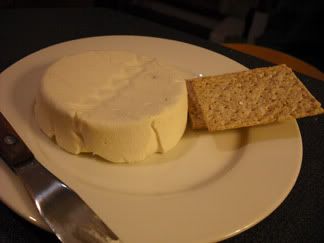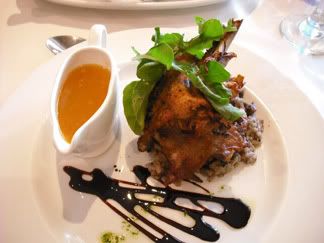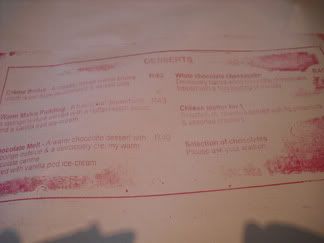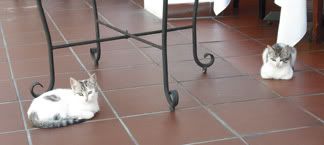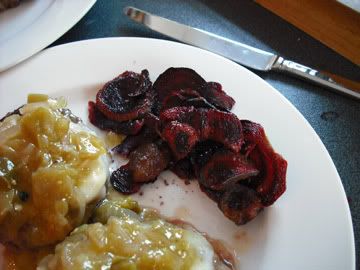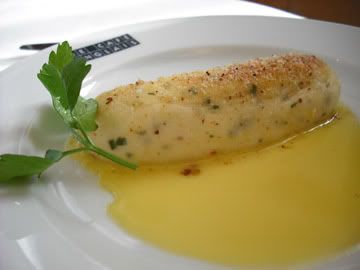I've been so looking forward to another year of
Cook the Books - our online book club where we go beyond talking about the books, to cook dishes inspired by them. The current round is being hosted by Rachel,
the Crispy Cook, and the deadline is January 22nd, so please visit Cook the Books after that date to see the roundup of reading-inspired dishes from around the blogosphere.
I don't know how other people feel, but I sometimes find it very difficult to start cooking again after a holiday. I feel a bit flat, a bit fed up and not very inspired. I know I want to eat something different, but it's all a bit
meh and I can't be bothered.
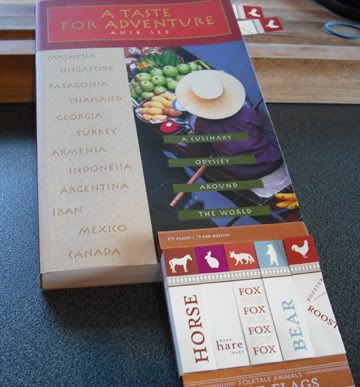
Our current book,
A Taste for Adventure by Anik See, was just the thing to get me out of my post-Christmas doldrums and back into foody experimentation. It was also a great excuse to use these cute sticky flags that I was given for Christmas. Aren't the little animals adorable? No more old envelopes marking pages in cookbooks for me!
Anik's spirit of adventure is totally alien to a nervous traveller like me. When I travel I need to know where I am sleeping at night, it needs to involve an actual bed and preferably indoor plumbing, and I need at least a vague idea of where I will be the following day. The idea of setting off into a country where I don't speak the language, armed with a bicycle and tent terrifies me. But her writing makes it sound bizarrely appealing.
I suspect there is the slightest element of rose-coloured glassery in these stories. Surely no one is so blessed as to encounter exclusively charming, delightful, hospitable people who offer delicious, nutritious food at the drop of a hat? Some people don't even get that at family Christmas dinners! But even with that slight scepticism, I found this book enticing. The people she meets, the food she tastes, the things she sees are all fascinating - and certainly not experiences you'd encounter travelling my way.
I had a great deal of difficulty deciding what to cook, inspired by
A Taste for Adventure. So many of the dishes sounded so good! I loved the account of the Patagonian barbecue, as prepared by holidaying butchers, but the thick layer of snow on the lawn made barbecuing not very practical. The Indonesian Gado Gado is an old favourite, but
I have recently blogged about it. Recipe after recipe begged me to try them. So at some stage, I intend to try making khachapuri, lahmacun, ali nazik kebabi and fesenjun with chelo. But not yet.
I decided that - as Singapore is the only country represented in the book that I have visited - I would make something from the opening chapter, on Malaysia and Singapore. When we were in Singapore, just for one night, almost exactly a year ago, we stayed in Little India. Anik says "I begin in Little India, where I lose myself in the back alleys for a couple of hours. I walk past piles and piles of spices: of vicious yellow turmeric; of tiny, fragrant pods of cardamom; of curiously shaped fenugreek" and it was exactly
that that drew me - the bustle and fragrance and chaos and mess, right in the middle of clean, air-conditioned Singaporean order.

I made two dishes - murtabak and Jagjit's dalcha.
I watched a couple of youtube videos trying to figure out the wrist flick needed for the roti dough and murtabak. And although I tried, it was totally beyond me, so I ended up cheating and using a rolling pin. Despite that, they were very good! I think if I make them again, I'll add a little salt or fish sauce to the beef filling - the spices were very nice, but it just needed to be a little saltier for my palate.
Jagjit's dalcha was also a big success. I don't usually put coconut milk in dhal, but it made a really delicious change. I felt that it needed just a touch more acid to make it really sing, perhaps the tamarind I was using wasn't as concentrated or something, and a squeeze of lime juice made it just perfect. I looked at the quantities, wondering what sort of bird-like people Anik had in mind when she said the recipe served 4, but it was so filling that even with our prodigious appetites that was about right. And in the way of curries, the leftovers reheated deliciously for another meal.
ETA - and now with bonus fesenjun. I had read elsewhere that traditionally, the Iranian pomegranate stew fesenjun was made with pheasant, now more commonly with chicken. Well I had an oven-ready pheasant in the freezer, so decided to have a go. Delicious! Strangely, the walnut and onion flavour reminded me of the old Cranks nutloaf recipe that my aunt makes. Delicious, but odd for a game dish! I served it with pilau rice (brown basmati cooked with a shallot, cinnamon, cardamom and saffron, finished with some dried cranberries) and a tomato salad.
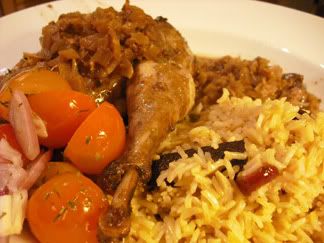
 The craving for melted cheese overwhelmed me. I ordered a fondue pot. Now, most of the time I don't feel particularly connected to my Swiss heritage - I don't even back Roger Federer in the tennis (although good luck to him in the Australian Open today) - but it all came bubbling out while I was looking for a fondue pot. Non-stick aluminium? What is this fuckery? How can you possibly make a caquelon from non-stick aluminium? The cheese needs to stick and you need to scrape the brown crispy bits off with the fork, to take that away is to deny the essential nature of the fondue experience!
The craving for melted cheese overwhelmed me. I ordered a fondue pot. Now, most of the time I don't feel particularly connected to my Swiss heritage - I don't even back Roger Federer in the tennis (although good luck to him in the Australian Open today) - but it all came bubbling out while I was looking for a fondue pot. Non-stick aluminium? What is this fuckery? How can you possibly make a caquelon from non-stick aluminium? The cheese needs to stick and you need to scrape the brown crispy bits off with the fork, to take that away is to deny the essential nature of the fondue experience!



